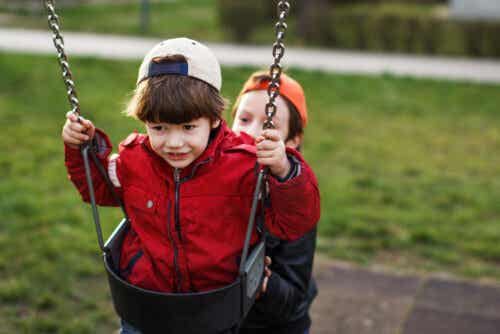The Need for Social Contact in Children


Written and verified by the social educator Natalia Cobos Serrano
Humans are born especially vulnerable compared to the rest of the species on our planet. To survive, infants and children require the presence and care of adults. These adults must attend to all their needs, including the need for social contact.
Why is social contact a necessity for children?
In order to live and coexist with others in society, human beings must develop the ability to establish and maintain social ties. Thus, as Juan Delval points out, it’s understandable that, throughout evolution, behaviors have been selected that favor contact with other human beings.
For example, a baby’s cry is produced as a reflex reaction to a feeling of discomfort. Although it’s not really a direct call or request, due to the human baby’s vulnerability, there must be an adult in the vicinity to approach and try to satisfy and comfort them.

Once the child responds to the attention and care of others, little by little, that first social contact will be consolidated in stable relationships with those they interact with.
The child’s first bond is what we know as attachment, which develops with the mother or primary caregiver. However, depending on how this bond has developed, the child will maintain a secure, insecure, avoidant, or ambivalent attachment.
Therefore, among the demands the child makes, those of a physiological nature, such as sleep, hunger, and thirst, are not alone. Children will also come to adults with the intention of interacting with them. That is, with the need for social contact.
The evolution of social development in children
From birth to later childhood, a series of behaviors develop that favor social contact between little ones and the people around them. Delval lists the different milestones in the establishment of the first social relationships.
- The social smile. This originates during the baby’s second month of life as a result of their interest in others. Initially, the smile will be triggered by internal stimuli, such as a sense of wellbeing. Gradually, however, the baby will begin to use the smile as a way of responding to different external stimuli.

- Attachment formation. Around the age of one year, the infant will begin to bond with the mother or primary caregiver. This is the first deep social bond that the individual establishes.
- Separation anxiety. Once the attachment bond exists, this phenomenon originates when the child is separated from their mother or main caregiver. That’s to say, the child develops a rejection toward not maintaining this social contact.
- Fear of strangers. Although babies react appropriately to strangers during the first months, they’ll gradually begin to show rejection toward people they don’t know and will try to maintain close contact with those who are beginning to establish relationships or even attachment.
Regarding the need for social contact in children
In short, we can observe that social contact is another basic need during childhood. However, we must add that this need for social contact is constituted as a function to promote social development and, in short, to establish relationships and bonds with others, which are essential for life in society.
Humans are born especially vulnerable compared to the rest of the species on our planet. To survive, infants and children require the presence and care of adults. These adults must attend to all their needs, including the need for social contact.
Why is social contact a necessity for children?
In order to live and coexist with others in society, human beings must develop the ability to establish and maintain social ties. Thus, as Juan Delval points out, it’s understandable that, throughout evolution, behaviors have been selected that favor contact with other human beings.
For example, a baby’s cry is produced as a reflex reaction to a feeling of discomfort. Although it’s not really a direct call or request, due to the human baby’s vulnerability, there must be an adult in the vicinity to approach and try to satisfy and comfort them.

Once the child responds to the attention and care of others, little by little, that first social contact will be consolidated in stable relationships with those they interact with.
The child’s first bond is what we know as attachment, which develops with the mother or primary caregiver. However, depending on how this bond has developed, the child will maintain a secure, insecure, avoidant, or ambivalent attachment.
Therefore, among the demands the child makes, those of a physiological nature, such as sleep, hunger, and thirst, are not alone. Children will also come to adults with the intention of interacting with them. That is, with the need for social contact.
The evolution of social development in children
From birth to later childhood, a series of behaviors develop that favor social contact between little ones and the people around them. Delval lists the different milestones in the establishment of the first social relationships.
- The social smile. This originates during the baby’s second month of life as a result of their interest in others. Initially, the smile will be triggered by internal stimuli, such as a sense of wellbeing. Gradually, however, the baby will begin to use the smile as a way of responding to different external stimuli.

- Attachment formation. Around the age of one year, the infant will begin to bond with the mother or primary caregiver. This is the first deep social bond that the individual establishes.
- Separation anxiety. Once the attachment bond exists, this phenomenon originates when the child is separated from their mother or main caregiver. That’s to say, the child develops a rejection toward not maintaining this social contact.
- Fear of strangers. Although babies react appropriately to strangers during the first months, they’ll gradually begin to show rejection toward people they don’t know and will try to maintain close contact with those who are beginning to establish relationships or even attachment.
Regarding the need for social contact in children
In short, we can observe that social contact is another basic need during childhood. However, we must add that this need for social contact is constituted as a function to promote social development and, in short, to establish relationships and bonds with others, which are essential for life in society.
All cited sources were thoroughly reviewed by our team to ensure their quality, reliability, currency, and validity. The bibliography of this article was considered reliable and of academic or scientific accuracy.
- Delval, J. (1996). El desarrollo humano. Siglo XXI Editores. Mexico.
This text is provided for informational purposes only and does not replace consultation with a professional. If in doubt, consult your specialist.








